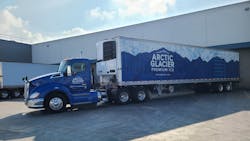If managing a fleet of 450 to 500 vehicles isn’t enough of a challenge, imagine what happens when the size of the operation doubles for a few months every year. That’s exactly the case at Arctic Glacier, a producer of ice products that delivers to 75,000 locations across North America.
Headquartered in Winnipeg, Manitoba, and Bala Cynwyd, Pennsylvania, Arctic Glacier operates a mix of 116 production and distribution centers. The company produces 2 billion lb. of bagged and packaged, block and crushed ice products annually. Heading up the company’s distribution and fleet operations is Dan Laurencelle, operations leader.
“When our fleet doubles in size during the summer, we rely heavily on partnerships with our equipment lessors to meet our seasonal rental needs,” he explained. “It takes all of our suppliers to make that happen because of our large operating footprint.”
See also: Navigating equipment shortages: Fleet and dealer insights
Arctic Glacier uses leasing companies for 95% of its year-round fleet and calls on those same companies for rental units during the peak summer season. Rental needs are met based on vehicle availability in different locations.
With such a large fleet and so many locations, Laurencelle noted, full-service leasing makes the most sense because it allows the company to invest capital in new plants or growth through acquisitions. It also assures maximum uptime, especially in the late spring and summer months when product demand increases three-fold.“It’s better for us to stick with one leasing company in a given area, so we try to use the same providers,” he said. “We also plan our lease terms to end in the spring every year so we can keep the operating units we’re going to replace through the summer at a lease rate. That’s not only more cost-effective but also helps meet our rental needs. Additionally, with current supply chain issues, we’re starting to see some delays in vehicle production, so this year especially that will be a helpful practice.”
PacLease provides Arctic Glacier with a mix of Peterbilt and Kenworth Classes 6-8 units. Also in the fleet are Freightliner and International trucks and tractors from Ryder, Penske, IdeaLease, NationaLease, and some local providers.
For truck bodies, Arctic Glacier prefers Morgan and Kidron, and in Canada Transit Trailer units. Its trailers are mostly Great Dane and Hyundai models leased from McKinney and Ryder. Specs call for 102-in. designs to accommodate pallets, roll-up rear doors, corrugated aluminum grocery-style floors, and hardwood scuff bands. All rail and tuckaway liftgates in the fleet are supplied by Maxon.
Another challenge: Meeting the season driver need
Along with equipment, meeting the seasonal need for drivers is challenging as well. Throughout the year, Arctic Glacier’s recruiting team focuses on attracting college students at career fairs and drivers from businesses that are slower in the summer, like school bus operations. Another steady source of help has been college athletic programs; coaches see the jobs as a great workout for their athletes.
Laurencelle said Arctic Glacier also is focused on safety. While the fleet operates under short-haul exemptions in most locations, it deploys Omnitracs XRS systems with electronic logging devices where needed. SmartDrive in-cab cameras are in place as well, including on seasonal rental units.
“Those systems are an important safety tool that have curbed a lot of unsafe behaviors because it’s better when you’re able to show drivers the issue they need to address,” he stated. “They’ve also been a benefit in exonerating drivers when the cameras prove they were not responsible.”
See also: How to add technology to your fleet
Laurencelle is equally proud of another accomplishment at Arctic Glacier, namely the 7% reduction in fuel used in 2020 compared to 2019. The effort was part of the company’s Project Summit. The result, he added, stemmed from more dynamic routing using software from Descartes, and this led to fewer miles driven. At the same time, the fleet has been spec’ing electric standby systems on refrigeration units, and it is looking forward to operating Kenworth T680 Next Generation tractors beginning this year.
For Laurencelle, who has been working at Arctic Glacier for 33 years, the fleet is integral to the company’s continued growth and success. “It’s a big part of our operation,” he said, “and our partners continue to play a vital role in making that happen.”





